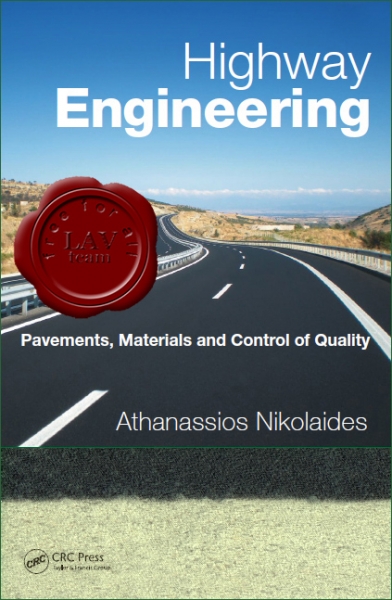Athanassios Nikolaides - Highway Engineering
Pavements, Materials and Control of Quality
CRC, 2015
pdf, 868 pages, english
ISBN-13: 978-1-4665-7997-2

Highway engineering is the term that replaced the traditional term road engineering used in the past, after the introduction of modern highways. Highway engineering is a vast subject that involves planning, design, construction, maintenance and management of roads, bridges and tunnels for the safe and effective transportation of people and goods.
This book concentrates on design, construction, maintenance and management of pavements for roads/highways. It also includes pavement materials since they are an integral part of pavements. It has been written for graduates, postgraduates as well as practicing engineers and laboratory staff and incorporates the author’s 30 years of involvement in teaching, researching and practicing the subject of highway engineering.
Advancements in pavement materials, design, construction, maintenance and pavement management and the globalisation of the market make it imperative for the highway engineer to be aware of the techniques and standards applied globally.
One of the objectives of the book is to provide integrated information on the abovementioned disciplines of highway engineering.
Another objective is to include in one book both European and American standards and practices (CEN EN, ASTM, AASHTO and Asphalt Institute). This would result in a more useful reference textbook to pavement engineering courses taught in European and American educational establishments.
Another objective of this book is to provide a reference textbook to practicing pavement engineers and materials testing laboratory staff, working in countries employing European or American standards and techniques.
Apart from information regarding European and American practices, the reader can also find some specific information on practices employed in countries such as the United Kingdom, France and Greece, as well as Australia.
In addition, this book also aims to provide integrated information related to pavement materials (soil, aggregates, bitumen, asphalts and reclaimed material), material testing for acceptability and quality assurance, asphalt mix design, flexible and rigid pavement design, construction, maintenance and strengthening procedures, quality control of production and acceptance of asphalts, pavement evaluation, asphalt plants and pavement recycling. It also covers the basic principles of pavement management.
The book in its 18 chapters contains many tables, graphs, charts and photographs to assist the reader in learning and understanding the subject of pavement engineering and materials. It also contains a great number of references, a valuable tool to help the reader seek more information and enhance his or her knowledge.
The short description of all pavement material testing procedures, required by Europeanand American standards, as well as pavement design and maintenance procedures covered, does not, by any means, substitute or replace the standards and procedures developed by the various organisations and agencies. The reader is advised to always consult the standards or manuals developed when engaged in testing, design, construction or maintenance works.
It is hoped that this textbook will not only contribute to the understanding of the wide and challenging subject of pavement engineering but also enable a more effective and economical design, construction and maintenance of pavements by employing updated standards, practices and techniques.